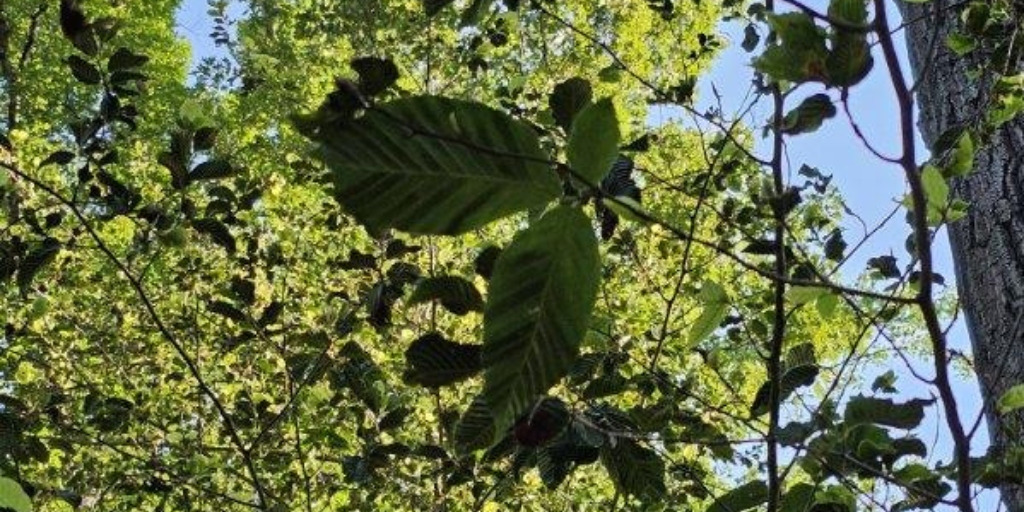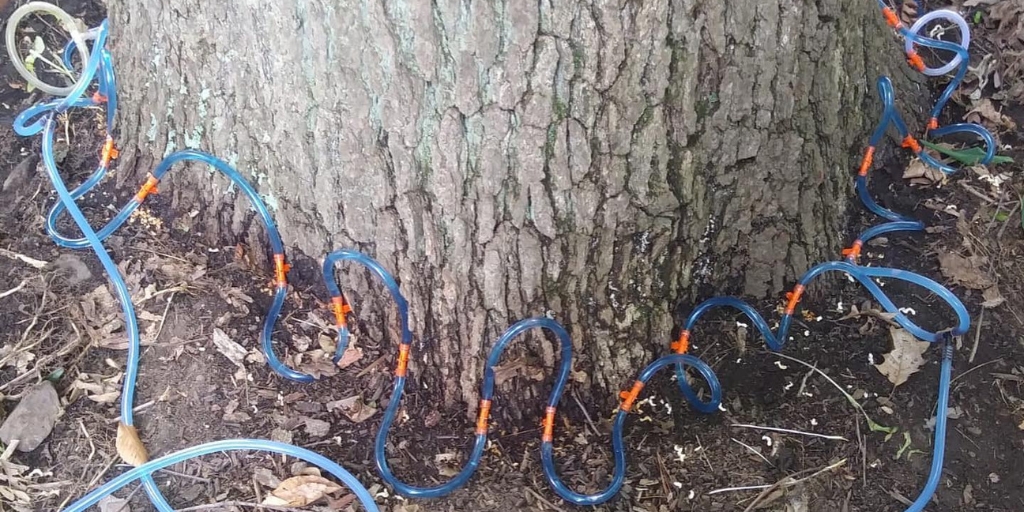Beech leaf disease (BLD) is a fatal disease targeting beech trees throughout the northeast; recently, it has been running rampant in New Jersey. The problem is especially bad in Morristown and the broader Morris County area. If you have beech trees on your property or live near a forest, you need to be aware of the signs of BLD so you can act quickly to help protect our native trees.
In this article, we examine beech leaf disease in New Jersey in depth. We’ll explore the causes of the disease, its typical symptoms, and what Alpine Tree is doing to treat it.
Key Takeaways
- BLD is a fatal tree disease that targets American, Oriental, European, and Chinese beech trees.
- Arborists first discovered the disease in 2012 in Ohio, and it has since spread throughout the northeastern United States.
- Microscopic nematodes cause beech leaf disease by draining nutrients from leaves.
- The most apparent sign of beech leaf disease is the dark banding that appears on infected leaves. As the disease progresses, the leaves will appear crinkled, copper, deformed, shriveled, and leathery.
- The Alpine Tree team uses the fungicide Arbotect 20-S to treat New Jersey trees with beech leaf disease.
Beech Leaf Disease in New Jersey: An Overview
When did beech leaf disease appear in New Jersey?
Arborists first detected BLD in Ohio in 2012, and the disease has quickly spread across much of the northeastern part of the country. In New Jersey, we first detected the disease in 2020 in Essex and Bergen counties. One year later, much of New Jersey reported the disease, including Morris County, Union County, and Somerset County. To date, we have confirmed cases of BLD in the following counties:
- Sussex
- Passaic
- Bergen
- Morris
- Essex
- Union
- Warren
- Somerset
- Hunterdon
- Middlesex
- Mercer
- Monmouth
- Burlington
- Salem
Does BLD affect all beech trees?
While the primary concern in New Jersey is our native American beech (Fagus grandifolia), this disease also targets European beech (F. sylvatica), Chinese beech (F. engleriana), and Oriental beech (F. orientalis).
WARNING: BLD is not the only disease to keep an eye out for with beech trees, as they also face threats from beech bark disease (BBD). BBD is another fatal tree disease that traces its roots back to the 1890s.
What impact will BLD have in New Jersey?
The American beech is an essential part of our forest’s ecosystems, providing both shelter and food (beechnuts) for our local wildlife. The spread of the disease has caused anxiety among New Jersey residents, especially because the USDA Forest Service’s Forest Inventory and Analysis Program estimates there are approximately 12 million beech trees in the state.
Students and administrators at Princeton University have also expressed worry about BLD, which threatens to destroy the beautiful beech trees on campus and in the surrounding area.
Emerald ash borer has already done extensive damage to the ash population, and substantial death in the beech population will further disrupt our forest ecosystem.
Causes of Beech Leaf Disease
Nematodes, microscopic worms also known as roundworms, cause BLD. The nematode Litylenchus crenatae ssp. mccannii (Lcm) is a parasite that feeds on beech leaves. Lcm does not affect the woody tissue, only the leaf buds and leaf tissue.
Lcm overwinters in the infected buds and lays eggs in the late winter or early spring. Observation has even shown these eggs survive in aborted buds. The nematodes reach a juvenile stage by the middle of summer, and the infection is most prominent at the end of the summer season and in early fall. As the winter approaches, the adults exit leaf tissue and migrate to buds to begin the cycle in the following year.
Research has shown that the adults spread at least 38 feet from infected beech trees due to wind and precipitation. Rainfall also transports Lcm nematodes from the higher portions of the canopy to the lower portions. Beech blight aphids (Bryylloprociphilus imbricator) and several bird species may carry nematodes to new trees and areas.

Looking up at beech leaves allows you to more easily identify the trademark dark banding that is the tell-tale sign of beech leaf disease infection.
Symptoms of Beech Leaf Disease in New Jersey
The first apparent symptom of BLD is dark stripes or bands on the lateral veins of beech leaves. Typically, you will notice these signs during bud break in the spring, and they may be unevenly distributed in the lower canopy. To help spot BLD, look up at leaves, as it is easier to notice the banding against a bright background like the sky.
As the disease progresses, other symptoms will appear, such as:
- Heavier banding on leaves
- Smaller leaves
- Leaves will have a leathery texture
- Leaves appear crinkled, deformed, or shriveled
- Leaves take on a copper color
- Premature leaf drop
- Aborted bud development
- Thinning canopy
The U.S. Forestry Service reports that tree mortality typically occurs within two to seven years and that the disease is more common in smaller trees.
PRO TIP: While we love our trees in New Jersey, they are unfortunately attacked by numerous pests and diseases. Check out some of our other articles on the topic of pests and diseases, such as:
How Alpine Tree is Dealing with Beech Leaf Disease in Morris County, NJ
Arborists have learned a lot about BLD since 2012, and we have developed treatment options to manage the disease and improve the tree’s health. At Alpine Tree, we are using the fungicide Arbotect 20-S to treat trees in our area showing symptoms of BLD. While Arbotect 20-S has traditionally been used to counteract Dutch elm disease and sycamore anthracnose, it is now a viable treatment for BLD.
In 2022, researchers conducted a study by injecting Arbotect 20-S into forest beeches with signs of BLD. They collected dormant buds in March 2023 and determined that fewer nematodes were in trees treated with Arbotect 20-S than in the control group with no injections. By the summer, treated trees showed fewer symptoms of BLD than untreated trees.
ArboTect 20-S now has a special local label recognizing its use in controlling the Lcm population in New Jersey beech trees.
If you have beech trees dealing with BLD, we can help. For the best results, we can inject Arbotect 20-S after full leaf expansion and up to late July or early August.
Tips to Slow the Spread of BLD in Morris County, NJ
Preventing trees from contracting BLD is the best thing we can do to protect New Jersey’s forests and your neighbor’s trees. We have a few tips you can follow to help control the spread of the deadly disease.
Keep Your Trees Healthy to Help Them Fight Off Diseases
Trees get stressed, just like us. When under stress, they aren’t as capable of resisting diseases. Follow these standard tree care practices to reduce tree stress and keep them healthy:
- Provide water during a drought.
- Apply a two-inch layer of mulch around your tree. Avoid piling it around the trunk; the root collar (where the trunk flares out at the base) should always be visible.
- Avoid mowing under the trees and eliminate foot traffic in the area to prevent soil compaction.
- Prune your trees to eliminate dead or diseased branches and those that rub against each other.
- Apply fertilizer if a soil test indicates a nutrient deficiency.
Report Any Possible Sightings of BLD
On a walk in a forest and notice the beech trees are displaying symptoms of BLD? Or have you determined your yard beeches may have BLD? The New Jersey Forest Service asks residents to report possible BLD by using the Tree Health Survey App or by contacting the service by email.
Suspect Beech Leaf Disease in Your Trees? Call Alpine Tree for Diagnosis & Treatment
With so many trees at stake, it’s crucial to know the signs of BLD so you can seek treatment. Still, not every tree can be saved, and you may have to remove dead beech trees the disease has damaged trees beyond saving. If you catch it early, the team at Alpine Tree can help.
At Alpine Tree, we’re staying at the cutting edge of treatment options, using Arbotect 20-S to reduce symptoms and the nematode population. If you have trees demonstrating the symptoms of BLD, don’t wait to seek help! Call us at 973-964-7798 or request an estimate online to schedule a tree inspection to diagnose BLD and start a treatment program as soon as possible.






